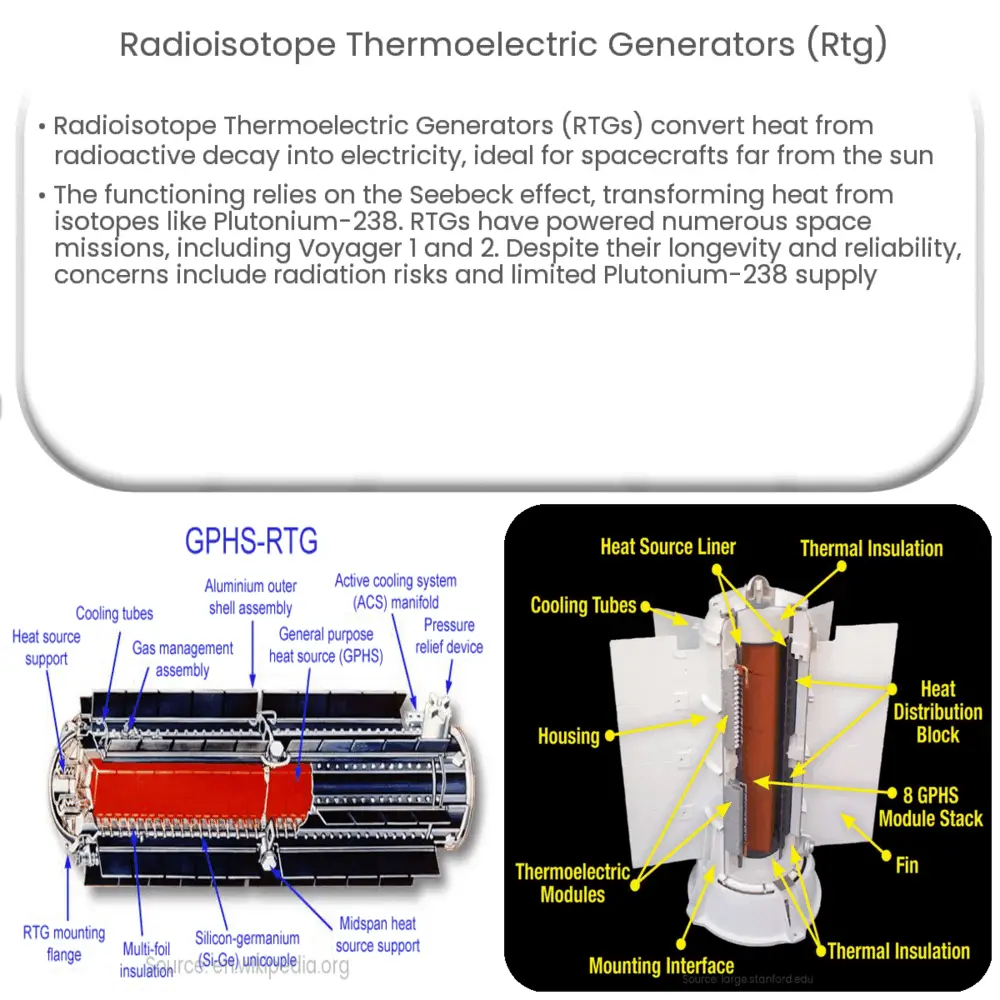Explore the science and applications of Radioisotope Thermoelectric Generators (RTGs), their role in space missions, and future potential.

Introduction to Radioisotope Thermoelectric Generators (RTGs)
Radioisotope Thermoelectric Generators (RTGs) are electrical generators that utilize the heat produced by radioactive decay to generate electricity. They have been primarily used in spacecraft that travel far from the sun, where solar power generation is not feasible.
The Science Behind RTGs
The primary principle that enables the functioning of an RTG is the heat generated from the radioactive decay of certain isotopes, like Plutonium-238238 or Strontium-9090. The generated heat is then converted into electricity through the Seebeck effect, which is a phenomenon that produces a voltage difference in a conductive material when subjected to a temperature gradient.
Structure of an RTG
The basic structure of an RTG includes three essential parts: the radioisotope fuel, the thermoelectric converters, and the heat rejection system.
- Radioisotope Fuel: This is typically a pellet of radioactive material, such as Plutonium-238, that undergoes natural radioactive decay, thereby emitting heat.
- Thermoelectric Converters: These devices, often made of specific pairs of metals, convert the heat from the radioactive decay into electricity. They do this using the Seebeck effect.
- Heat Rejection System: Not all the heat generated can be converted into electricity. The excess heat is dissipated using fins or radiators, which are part of the heat rejection system.
Applications of RTGs
RTGs have found extensive use in space missions due to their reliable, long-lasting power supply capabilities. They have powered missions to the moon, Mars, and even the outer reaches of our solar system. A few noteworthy space missions that utilized RTGs include:
- Voyager 1 and 2: These spacecraft, launched by NASA in the late 1970s, used RTGs for power. Both are now in interstellar space, making them the farthest human-made objects from Earth.
- New Horizons: This mission to Pluto and the Kuiper Belt also utilized an RTG for power.
Advantages and Disadvantages of RTGs
RTGs come with a set of advantages that make them quite unique as power sources, especially in space exploration:
- Longevity: The RTGs can provide power over extended periods, even several decades, which makes them suitable for long-term space missions.
- Reliability: RTGs are reliable power sources that function independently of sunlight or other external conditions, unlike solar panels.
- Compactness: These generators are compact and rugged, hence their preference in space missions where size and durability are of prime importance.
However, the use of RTGs is not without controversy or challenges:
- Radiation Risks: The handling and disposal of RTGs present potential radiation hazards. Also, in the event of a launch failure, there is a risk of radioactive contamination.
- Supply of Plutonium-238: Plutonium-238, the most commonly used fuel in RTGs, is in limited supply and is difficult and costly to produce.
Future of RTGs
RTGs continue to play a significant role in space exploration. NASA’s Perseverance Rover, which landed on Mars in 2021, is powered by an RTG, indicating that they will remain a staple for future missions. Research is also underway to improve the efficiency of RTGs and explore alternative radioisotopes for use as fuel.
Conclusion
In conclusion, Radioisotope Thermoelectric Generators (RTGs) are a pivotal technology in the field of space exploration and beyond. Their ability to provide long-lasting, reliable power in harsh environments and independent of sunlight makes them an irreplaceable component for various missions. While there are challenges and risks associated with their use, advancements in technology and improved safety protocols continue to enhance the viability of RTGs. Looking forward, RTGs will undoubtedly continue to illuminate our path as we delve deeper into the mysteries of the cosmos.

